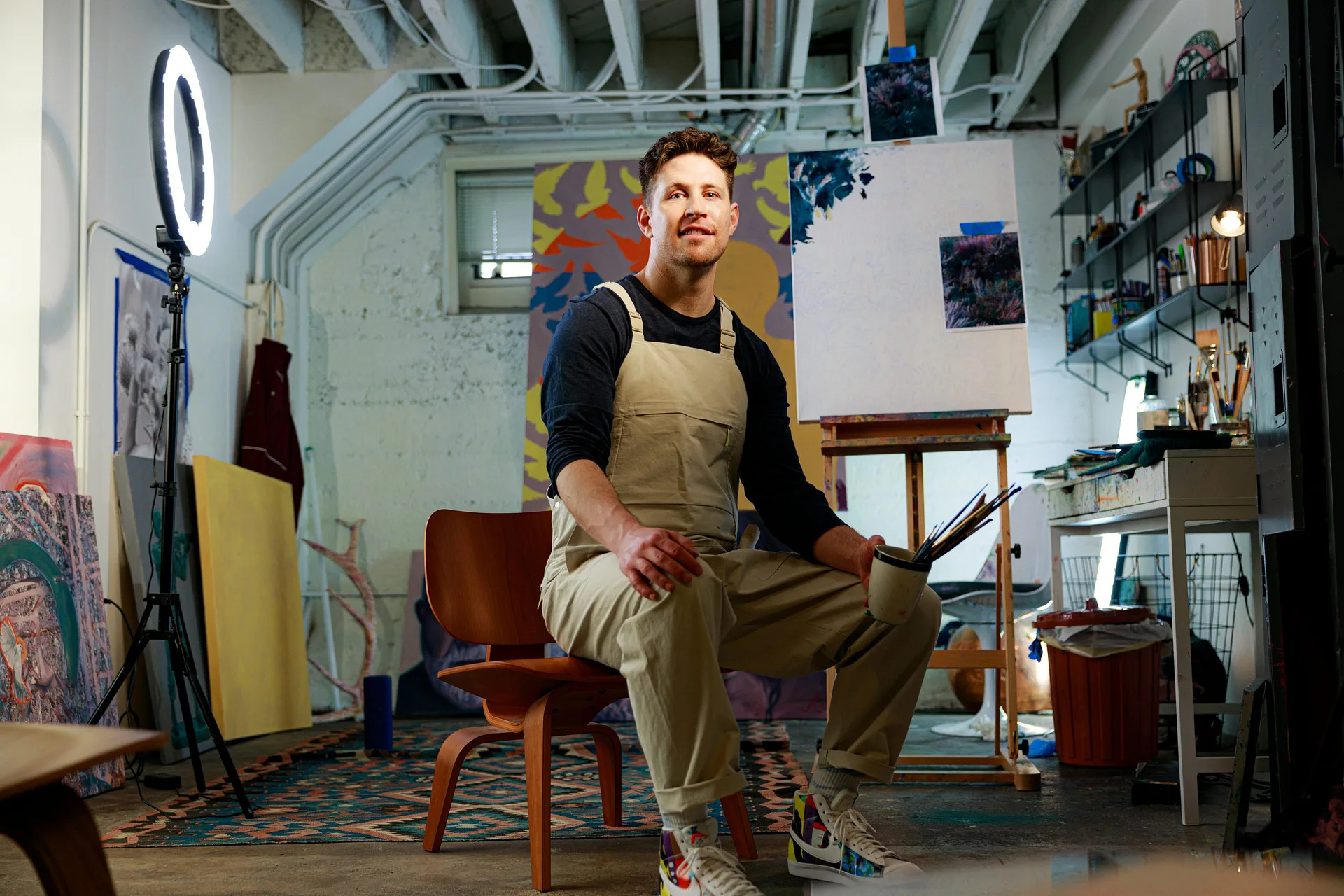
Alex Grobstein’s Petals of Perception
Art
Alex Grobstein’s paintings begin as photographs. These photos, which Grobstein takes himself, are catalysts for work that subtly challenges one’s perspective and assumptions. He plays with style to challenge the rules, sometimes painting photo-surrealism and other times abstractions of nature.
With no formal training in the craft, Grobstein has honed his skills by studying in museums. In particular, he developed his artistry in the Van Gogh museum during a year-long stay in Amsterdam. Grobstein has also spent significant time researching formal concepts online, such as color theory. He explains how he was lucky to grow up around his mother, who was an art history teacher and fostered respect for artistic inclinations. At the same time, his obsessive-compulsive disorder (OCD) caused him to fixate on clothing textures and cleanliness. Picking up a pen and pad of paper allowed him to escape the anxiety that the all-consuming thought cycles created. Drawing became a respite, which was when passion and intrinsic motivation were born. He simply had to create art.
“I think there’s a belief that you have to be good at something to pursue it, and I don’t think that is always true.”
As an adult, it would be a while before Grobstein pursued art full-time. With some bravery and a little luck, he forewent a 9–5 for his art. “I’ve always felt like an artist,” says Grobstein. “I even denied what’s in me to fit a cultural stereotype of success. I tried to do everything else, but this is what makes me happy. Wherever I am, I am happiest [when] I am creating, so I had to.”
Grobstein is impassioned to challenge the heuristic truths we all tend to accept as reality. His goal is to expel the boredom created by these accepted realities. Could there be something unseen in what is seen every day? What do we ignore in our effort to make sense of the world? That is what Grobstein’s paintings ask. 
Last summer, Grobstein stayed alone at a cabin in the Uintas. Every day ended at the same spot on the lake beach. “I was so moved by the image and the way the colors would change in the same location time and time again,” he says. “I have over 300 photos of the same shot, and each one has a new color scheme due to the changes in sunlight. That just breathes life into me.” The way light changed the scene’s colors and their emotive energy hooked him. Looking at his paintings, one can see that color is where Grobstein plays the most. They typically follow a pattern wherein dark colors tend to lean warmer, and light colors are cooler. This is not a conventional way of mixing color, but as Grobstein says, “I like the way this [method of using color and tone] moves your eye around the canvas. It does so in a way that I think is intriguing.”
Grobstein’s piece “Mono Iris in Green” is a display of his own color theory. A well-planned whirl of cool and warm tones guides your eye. Leafy petals circinate what could be a mushroom or a pollen-producing stamen. A subtle commentary on the pollinator rests at the center of the canvas. The hallucinogenic quality of the various shades of green urges one to see more of Grobstein’s innuendo. Rippling textures evoke a sense of movement, of an inhale and exhale, in the painting. The strokes creating the veins in each petal build a sense of purposeful wantonness. Reality can be as fragile as a petal.
Grobstein feels a desire for a highly regimented environment. The photographs that he takes typically inspire all of his paintings, and there you’ll find the seeds of method: rigidity, geometric lines, no unintended people, a lack of chaos and an abundance of order. “I don’t like using photographs taken by other people,” he says, “only if it’s a famous photo I am using for a cultural statement, because there is a need to control the environment in my photography.” The process of painting his photography is where Grobstein therapeutically allows the chaos in letting go. Grobstein acknowledges the importance of conventional therapy and familial support, but gives a nod to painting as a tool just the same. “If you compare me now to when I was a kid, it really is a night and day difference.”
“I even denied what’s in me to fit a cultural stereotype of success. I tried to do everything else, but this is what makes me happy. Wherever I am, I am happiest [when] I am creating, so I had to.”
The engine within Grobstein directs his eye toward mother nature’s ability to slip into something new. His work invigorates his subjects by challenging our culture’s norms around them. Grobstein believes that painting forces one to focus on continuous improvement, as well as challenging one to forgo the rules. He describes this dichotomy as exigent and exquisite. “I think there’s a belief that you have to be good at something to pursue it, and I don’t think that is always true.” It’s clear that on Grobstein’s canvas, there is a tension before your eyes—between orderly chaos, perfectly broken rules and Grobstein’s own growth.
Find more of Alex Grobstein’s work on Instagram at @alexgrobstein.
Read about more local artists and painters:
Sophie Schwabacher: Tapping Beer Nostalgia with Watercolor
“Colorful, Angry, Happy”: Activist Mariella Mendoza Uses Art As a Call-to-Action
